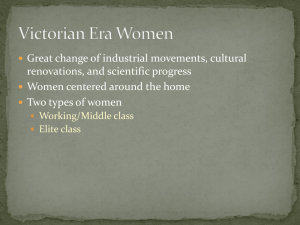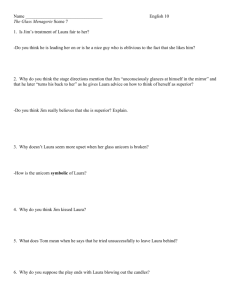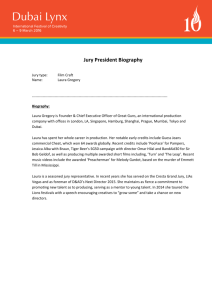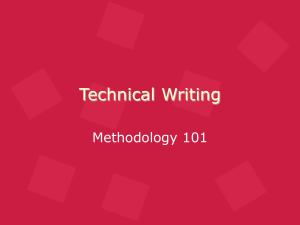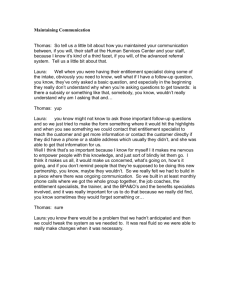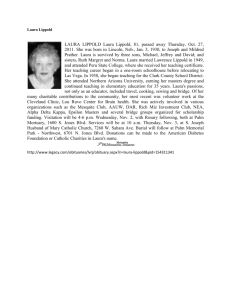REFLECTING ON PROSPECTIVE ELEMENTARY TEACHERS’ MATHEMATICS CONTENT KNOWLEDGE: THE CASE OF LAURA
advertisement
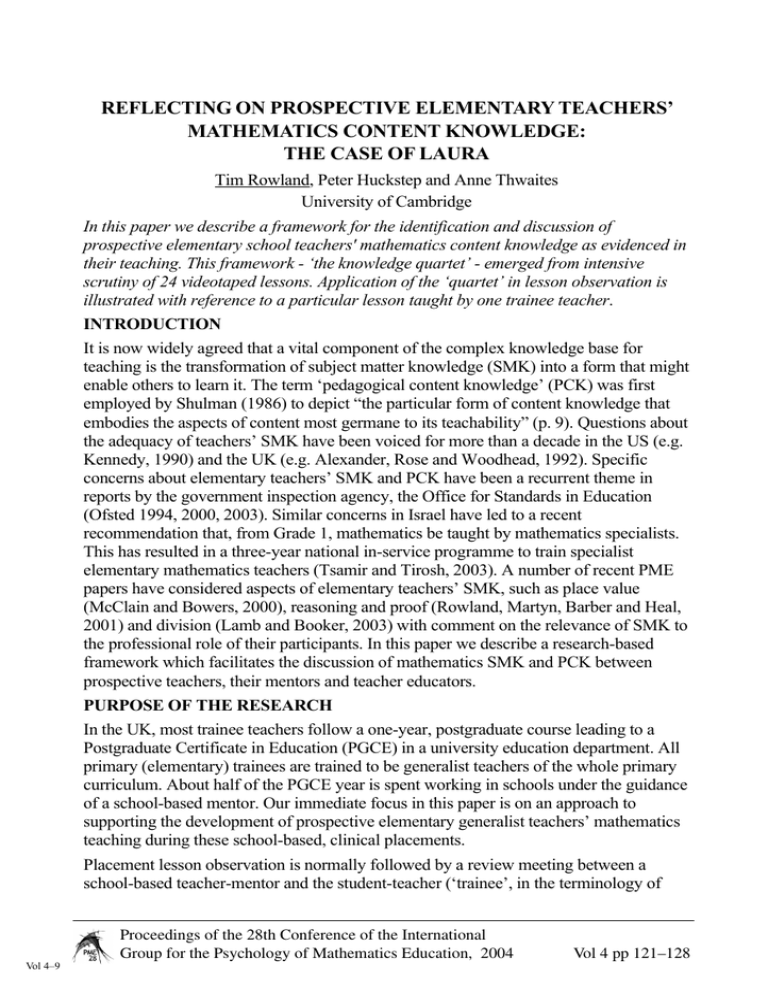
REFLECTING ON PROSPECTIVE ELEMENTARY TEACHERS’ MATHEMATICS CONTENT KNOWLEDGE: THE CASE OF LAURA Tim Rowland, Peter Huckstep and Anne Thwaites University of Cambridge In this paper we describe a framework for the identification and discussion of prospective elementary school teachers' mathematics content knowledge as evidenced in their teaching. This framework - ‘the knowledge quartet’ - emerged from intensive scrutiny of 24 videotaped lessons. Application of the ‘quartet’ in lesson observation is illustrated with reference to a particular lesson taught by one trainee teacher. INTRODUCTION It is now widely agreed that a vital component of the complex knowledge base for teaching is the transformation of subject matter knowledge (SMK) into a form that might enable others to learn it. The term ‘pedagogical content knowledge’ (PCK) was first employed by Shulman (1986) to depict “the particular form of content knowledge that embodies the aspects of content most germane to its teachability” (p. 9). Questions about the adequacy of teachers’ SMK have been voiced for more than a decade in the US (e.g. Kennedy, 1990) and the UK (e.g. Alexander, Rose and Woodhead, 1992). Specific concerns about elementary teachers’ SMK and PCK have been a recurrent theme in reports by the government inspection agency, the Office for Standards in Education (Ofsted 1994, 2000, 2003). Similar concerns in Israel have led to a recent recommendation that, from Grade 1, mathematics be taught by mathematics specialists. This has resulted in a three-year national in-service programme to train specialist elementary mathematics teachers (Tsamir and Tirosh, 2003). A number of recent PME papers have considered aspects of elementary teachers’ SMK, such as place value (McClain and Bowers, 2000), reasoning and proof (Rowland, Martyn, Barber and Heal, 2001) and division (Lamb and Booker, 2003) with comment on the relevance of SMK to the professional role of their participants. In this paper we describe a research-based framework which facilitates the discussion of mathematics SMK and PCK between prospective teachers, their mentors and teacher educators. PURPOSE OF THE RESEARCH In the UK, most trainee teachers follow a one-year, postgraduate course leading to a Postgraduate Certificate in Education (PGCE) in a university education department. All primary (elementary) trainees are trained to be generalist teachers of the whole primary curriculum. About half of the PGCE year is spent working in schools under the guidance of a school-based mentor. Our immediate focus in this paper is on an approach to supporting the development of prospective elementary generalist teachers’ mathematics teaching during these school-based, clinical placements. Placement lesson observation is normally followed by a review meeting between a school-based teacher-mentor and the student-teacher (‘trainee’, in the terminology of Vol 4–9 Proceedings of the 28th Conference of the International Group for the Psychology of Mathematics Education, 2004 Vol 4 pp 121–128 recent official UK documentation). On occasion, a university-based tutor will participate in the observation and the review. Research shows that such meetings typically focus heavily on organisational features of the lesson, with very little attention to mathematical aspects of mathematics lessons (Brown, McNamara, Jones and Hanley, 1999). The purpose of the research reported in this paper was to develop an empirically-based conceptual framework for the discussion of the role of trainees’ mathematics SMK and PCK, in the context of lessons taught on the school-based placements. Such a framework would need to capture a number of important ideas and factors about content knowledge within a small number of conceptual categories, with a set of easily-remembered labels for those categories. METHOD This study took place in the context of a one-year PGCE course, in which 149 trainees followed a route focusing either on the ‘lower primary’ years (LP, ages 3-8) or the ‘upper primary’ (UP, ages 7-11). Six trainees from each of these groups were chosen for observation during their final school placement. Two mathematics lessons taught by each of these trainees were observed and videotaped, i.e. 24 lessons in total. Following the lesson, the observer/researcher wrote a brief (400-500 words) descriptive synopsis of the lesson. From that point, we took a grounded approach to the data for the purpose of generating theory (Glaser and Strauss, 1967). In particular, we identified aspects of trainees’ actions in the classroom that seemed to be significant in the limited sense that it could be construed to be informed by their mathematics SMK or PCK. These were grounded in particular moments or episodes in the tapes. This inductive process generated a set of 18 codes. Next, we revisited each lesson in turn and, after intensive study of the tapes, elaborated each descriptive synopsis into an ‘analytical account’ of the lesson. In these accounts, significant moments and episodes were identified and coded, with appropriate justification and analysis concerning the role of the trainee’s content knowledge in the identified passages, with links to relevant literature. Our catalogue of 18 codes presented us with the following problem. We intended to offer our findings to colleagues for their use, as a framework for reviewing trainees’ mathematics content knowledge from evidence gained from classroom observations of teaching. We anticipate, however, that 18 codes is too many to be useful for a one-off observation. Our resolution of this dilemma was to group them into four broad, superordinate categories, or ‘units’, which we term ‘the knowledge quartet’. FINDINGS We have named the four units of the knowledge quartet as follows: foundation; transformation; connection; contingency. Each unit is composed of a small number of cognate subcategories. For example, the third of these, connection, is a synthesis of four of the original 18 codes, namely: making connections; decisions about sequencing; anticipation of complexity, and recognition of conceptual appropriateness. Our scrutiny of the data suggests that the quartet is comprehensive as a tool for thinking about the ways that subject knowledge comes into play in the classroom. However, it will become 4–122 PME28 – 2004 apparent that many moments or episodes within a lesson can be understood in terms of two or more of the four units; for example, a contingent response to a pupil’s suggestion might helpfully connect with ideas considered earlier. Furthermore, it could be argued that the application of subject knowledge in the classroom always rests on foundational knowledge. Drawing on the extensive range of data from the 24 lessons, we offer here a brief conceptualisation of each unit of the knowledge quartet. The first category, foundation, consists of trainees’ knowledge, beliefs and understanding acquired ‘in the academy’, in preparation (intentionally or otherwise) for their role in the classroom. The key components of this theoretical background are: knowledge and understanding of mathematics per se and knowledge of significant tracts of the literature on the teaching and learning of mathematics, together with beliefs concerning the nature of mathematical knowledge, the purposes of mathematics education, and the conditions under which pupils will best learn mathematics. The second category, transformation, concerns knowledge-in-action as demonstrated both in planning to teach and in the act of teaching itself. As Shulman indicates, the presentation of ideas to learners entails their re-presentation (our hyphen) in the form of analogies, illustrations, examples, explanations and demonstrations (Shulman, 1986, p. 9). Of particular importance is the trainees’ choice and use of examples presented to pupils to assist their concept formation, language acquisition and to demonstrate procedures. The third category, connection, binds together certain choices and decisions that are made for the more or less discrete parts of mathematical content. In her discussion of ‘profound understanding of fundamental mathematics’, Liping Ma cites Duckworth’s observation that intellectual ‘depth’ and ‘breadth’ “is a matter of making connections” (Ma, 1999, p. 121). Our conception of this coherence includes the sequencing of material for instruction, and an awareness of the relative cognitive demands of different topics and tasks. Our final category, contingency, is witnessed in classroom events that are almost impossible to plan for. In commonplace language it is the ability to ‘think on one’s feet’. In particular, the readiness to respond to children’s ideas and a consequent preparedness, when appropriate, to deviate from an agenda set out when the lesson was prepared. LAURA’S LESSON AND THE KNOWLEDGE QUARTET We now proceed to show how this theoretical construct, the knowledge quartet, might be applied, by detailed reference to just one of the 24 videotaped lessons. The trainee in question, Laura, was teaching a Year 5 (pupil age 9-10) class about written multiplication methods. By focusing on just one lesson we aim to maximise the possibility of the reader’s achieving some familiarity with Laura and the children in her class, as well as the structure and the flow of her lesson. Conforming to National Numeracy Strategy guidance (DfEE, 1999), Laura segments the lesson into three distinctive and readily-identifiable phases: the mental and oral starter; the main activity (an introduction by the teacher, followed by group work, with tasks differentiated by pupil ability); and the concluding plenary. The key focus of this lesson is on teaching column multiplication of whole numbers, specifically multiplying a twodigit number by a single digit number. After Laura has settled the class on the carpet in PME28 – 2004 4–123 front of her, the lesson begins with a three-minute mental and oral starter, in which the children rehearse recall of multiplication bonds. There follows a 15-minute introduction to the main activity. Laura reminds the class that they have recently been working on multiplication using the ‘grid’ method. She speaks about the tens and units being “partitioned off”. Simon is invited to the whiteboard to demonstrate the method for 9x37. He writes: x 9 30 270 7 63 = 333 Laura then says that they are going to learn another way. She proceeds to write the calculation for 9x37 on the whiteboard in a conventional but elaborated column format, explaining as she goes along: x 30x9 7x9 37 9 270 63 333 1 Laura performs the sum 270+63 by column addition from the right, ‘carrying’ the 1 (from 7+6=13) from the tens into the hundreds column. She writes the headings h, t, u above the three columns. Next, Laura shows how to “set out” 49x8 in the new format, followed by the first question (19x4) of the exercises to follow. The class proceeds to 24 minutes’ work on exercises that Laura has displayed on the wall. Laura moves from one child to another to see how they are getting on. She emphasises the importance of lining up the hundreds, tens and units columns carefully, and reminds them to estimate first. Eventually, she calls them together on the carpet for an eight-minute plenary. She asks one boy, Sean, to demonstrate the new method with the example 27x9. Sean gets into difficulty; he is corrected by other pupils and by Laura herself. As the lesson concludes, Laura tells the children that they should complete the set of exercises for homework. We now select from Laura’s lesson a number of moments, episodes and issues to show how they might be perceived through the lens of ‘the knowledge quartet’. It is in this sense that we offer Laura’s lesson as a ‘case’ - it is typical of the way that the quartet can be used to identify for discussion matters that arise from the lesson observation, and to structure reflection on the lesson. Some possibilities for discussion with the trainee, and for subsequent reflection, are flagged below thus: Discussion point. We emphasise that the process of selection in the commentary which follows has been extreme. Nevertheless, we raise more issues relating to content knowledge than would normally be considered in a post-lesson review meeting. Foundation First, Laura’s professional knowledge underpins her recognition that there is more than one possible written algorithm for whole number multiplication. We conceptualise this within the domain of fundamental knowledge, being the foundation that supports and 4–124 PME28 – 2004 significantly determines her intentions or actions. Laura’s learning objective seems to be taken from the National Numeracy Strategy (NNS) Framework (DfEE, 1999) teaching programme for Year 4: Approximate first. Use informal pencil and paper methods to support, record or explain multiplication. Develop and refine written methods for TUxU (p. 3/18, emphasis added) These objectives are clarified by examples later in the Framework; these contrast (A) informal written methods - the grid, as demonstrated by Simon - with (B) standard written methods - the column layout, as demonstrated by Laura in her introduction. In both cases (A and B), an ‘approximation’ precedes the calculation of a worked example in the Framework. Laura seems to have assimilated the NNS guidance and planned her teaching accordingly. It is perhaps not surprising that she does not question the necessity to teach the standard column format to pupils who already have an effective, meaningful algorithm at their disposal. The NNS distinguishes between ‘effective’ and ‘efficient’ methods and favours the latter. The suggestion in this case is that the ‘standard’ method B is efficient whereas the ‘informal’ grid method is effective i.e. it merely works. On the other hand, a best-selling handbook for trainee primary teachers, written by a respected teacher educator, explains why the standard algorithm works, but forcibly advocates the adequacy and pedagogical preference of grid-type methods with primary pupils (Haylock, 200, pp. 91-94). Discussion point: where does Laura stand on this debate, and how did this contribute to her approach in this lesson? Another issue related to Laura’s fundamental knowledge is her approach to computational estimation. When she asks the children to estimate 49x8, one child proposes 400, saying that 8x50 is 400. Laura, however, suggests that she could make this “even more accurate” by taking away two lots of 50. She explains, “Because you know two times five is ten and two times fifty is a hundred, you could take a hundred away”. Perhaps she had 10x50 in mind herself as an estimate, or perhaps she confused something like subtracting 8 from the child’s estimate. She recognises her error and says “Sorry, I was getting confused, getting my head in a spin”. The notions of how to estimate and why it might be desirable to do so are not adequately discussed or explored with the class. Discussion point: what did Laura have in mind in this episode, and is there some way she can be more systematic in her approach to computational estimation? At this stage of her career in teaching, Laura gives the impression that she is passing on her own practices and her own forms of knowledge. Her main resource seems to be her own experience (of using this algorithm), and it seems that she does not yet have a view of mathematics didactics as a scientific enterprise. Transformation Laura’s own ability to perform column multiplication is secure, but her pedagogical challenge is to transform what she knows for herself into a form that can be accessed and appropriated by the children. Laura’s choice of demonstration examples in her PME28 – 2004 4–125 introduction to column multiplication merits some consideration and comment. Her first example is 379; she then goes on to work through 498 and 194. Now, the NNS emphasises the importance of mental methods, where possible, and also the importance of choosing the most suitable strategy for any particular calculation. 498 and 194 can all be more efficiently performed by rounding up, multiplication and compensation e.g. 498 = (508)-8. Perhaps Laura had this in mind in her abortive effort to make the estimate of 400 “even more accurate”. Her choice of exercises - the practice examples - also invites some comment. The sequence is: 19x4, 27x9, 42x4, 23x6, 37x5, 54x4, 63x7, 93x6, with 99x9, 88x3, 76x8, 62x43, 55x92, 42x15 as ‘extension’ exercises (although no child actually attempts these in the lesson). Our earlier remark about the suitability of the column algorithm relative to alternative mental strategies applies to several of these, 99x9 being a notable example. But suppose for the moment that it is understood and accepted by the pupils that they are to put aside consideration of such alternative strategies - that these exercises are there merely as a vehicle for them to gain fluency with the algorithm. In that case, the sequence of exercises might be expected to be designed to present the pupils with increasing challenge as they progress though them. This challenge would be of two kinds. First, the partial products (e.g. 10x4 and 9x4) make demands on their recall of products, but consideration of this dimension is not apparent in the sequence. Secondly, the necessity of ‘carrying’ when summing the tens digits of the partial products would add to the complexity of an exercise. This is a factor only in the second of the first eight exercises, 27x9, and in the third of the extension items, 76x8. Discussion point: on what grounds did Laura choose these particular examples and exercises? What considerations might contribute to the choice? Connection Perhaps the most important connection to be established in this lesson is that between the grid method and the column algorithm. Laura seems to have this connection in mind as she introduces the main activity. She reminds them that they have used the grid method, and says that she will show them a “slightly different way of writing it down”, although after the first example is completed Laura says that they are learning a “different way to work it out”. She says that the answer would be the same whichever way they did it “because it’s the same sum”. Of course, that presupposes that both methods are valid, but does not clarify the connection between them: that the same processes and principles - partition, distributivity and addition - are present in both methods. The fact that Laura includes demonstrations of 37x9 by both methods does help to establish the connection, but the effort to sustain the connection is not maintained, and no reference to the grid method is made in her second demonstration example, 49x8. Her presentation of this example now homes in on procedural aspects the need to “partition the number down”, “adding a zero” to 8x4, getting the columns lined up, adding the partial products from the right. The fact that the connection is tenuous for at least one pupil is apparent in the plenary. Sean actually volunteers to 4–126 PME28 – 2004 calculate 27x9 on the whiteboard. He writes 27 and x9 in the first two rows as expected, but then writes 20x7 and 2x9 to the left in the rows below. Discussion point: Laura is clearly trying to make a connection between the grid method and the column method. What reasons did she have in mind for doing so? To what extent did she think she was successful? Contingency Sean’s faulty attempt (mentioned above) to calculate 27x9 on the whiteboard appears to have caught Laura ‘on the hop’. Laura does not notice Sean’s error immediately - it seems that she fully expected him to apply the algorithm faultlessly, and that his actual response really was unanticipated. In the event, there are several ‘bugs’ in his application of the procedure. The partition of 27 into 20 and 2 is faulty, and the multiplicand is first 9, then 7. This would seems to be a case where Sean might be encouraged to reconsider what he has written by asking him some well-chosen questions. One such question might ask how he would do it by the grid method. Or simply why he wrote those particular numbers where he did. Laura avoids correcting Sean herself, although her response indirectly suggests that all is not well. She asks the class? “Is that the way to do it? Would everyone do it that way?”. Leroy demonstrates the algorithm correctly, but there is no diagnosis of where Sean went wrong, or why. Discussion point: what might be the reason for Sean’s error? In what ways could this have been addressed in the lesson, or subsequently? FINAL COMMENTS AND CAVEATS In this paper, we have introduced ‘the knowledge quartet’ and shown its relevance and usefulness in our analysis of Laura’s lesson on written methods of multiplication with a Year 5 class. We have a manageable framework within which to discuss actual, observed teaching sessions with trainees and their mentors. These groups of participants in initial teacher preparation, as well as our university-based school colleagues, will need to be acquainted with (and convinced of the value of) the quartet, and to become familiar with some details of its conceptualisation, as described in this paper. Steps towards this familiarisation are already in place in the context of our own university’s initial teacher education programme. It is all too easy for an observer to criticise a novice teacher for what they omitted or committed in the high-stakes environment of a school placement, and we would emphasise that the quartet is intended as a tool to support teacher development, with a sharp and structured focus on the impact of their SMK and PCK on teaching. Indications of how this might work are explicit in our analysis of Laura’s lesson. We have emphasised that our analysis has been selective: we raised for attention some issues, but there were others which, not least out of space considerations, we chose not to mention. The same would be likely to be true of the review meeting - in that case due to time constraints, but also to avoid overloading the trainee with action points. Each such meeting might well focus on only one or two dimensions of the knowledge quartet for similar reasons. PME28 – 2004 4–127 Any tendency to descend into deficit discourse is also tempered by consideration of the wider context of the student teacher’s experience in school. In the novice teacher we see the very beginnings of a process of reconciliation of pre-existing beliefs, new ‘theoretical’ knowledge, ‘practical’ advice received from various quarters, in the context of highly-pressured, high-stakes school-based placements. There is also good evidence (e.g. Hollingsworth, 1988; Brown et al., 1999) that trainees’ concern for pupil learning is often eclipsed by their anxieties about timing, class management and pupil behaviour. References Alexander R., Rose J., and Woodhead C. (1992) Curriculum Organisation and Classroom Practice in Primary Schools. London: Department for Education and Science. Brown, T., Mcnamara, O., Jones, L. and Hanley, U. (1999) ‘Primary student teachers’ understanding of mathematics and its teaching.’ British Education Research Journal, 25(3), pp. 299-322. DfEE (1999) The National Numeracy Strategy: framework for teaching mathematics from Reception to Year 6. Sudbury: DfEE Publications. Glaser, B. G. and Strauss, A. L. (1967) The Discovery of Grounded Theory: Strategies for Qualitative Research. New York: Aldine de Gruyter. Haylock, D. (2001) Mathematics Explained for Primary Teachers. London: Paul Chapman. Hollingsworth, S. (1989) ‘Prior beliefs and cognitive change in learning to teach.’ American Educational Research Journal 26, pp. 160-189. Kennedy, M. (1990) ‘A survey of recent literature on teachers' subject matter knowledge.’ Issue Paper IP 90-3. Michigan State University: National Center for Research on Teacher Learning Lamb, J. and Booker, G. (2003) ‘The impact of teachers’ understanding of division on students’ division knowledge’. In A Pateman, D. Dougherty and J. Zilliox (Eds.) Proceedings of PME27. Vol. 1, p. 207. Honolulu: University of Hawaii. Ma, L. (1999) Knowing and teaching mathematics: teachers understanding of fundamental mathematics in China and the United States. Mahwah, NJ: Lawrence Eribaum. MacClain K. and Bowers, J. (2000) ‘Supporting pre-service teachers’ understanding of place value’. In Nakahara, T. and Koyama, M. (Eds.) Proceedings of PME24. Vol. 4, pp. 279-286. Hiroshima: University of Hiroshima. Ofsted (1994) Science and Mathematics in schools: a review. London: HMSO. Ofsted (2000) The National Numeracy Strategy: the first year: a report from HM Chief Inspector of Schools. London: HMSO Ofsted (2003) The National Literacy and Numeracy Strategies and The Primary Curriculum. London: Office for Standards in Education. Rowland, T., Martyn, S., Barber, P. and Heal, C. (2001) ‘Investigating the mathematics subject matter knowledge of pre-service elementary school teachers’. In M. van den HeuvelPanhuizen (ed.) Proceedings of the PME25, Vol. 4, pp. 121-128. Utrecht, Freudenthal Institute. Utrecht University Shulman, L. (1986) ‘Those who understand: knowledge growth in teaching’. Educational Researcher 15(2), pp 4-14. 4–128 PME28 – 2004

